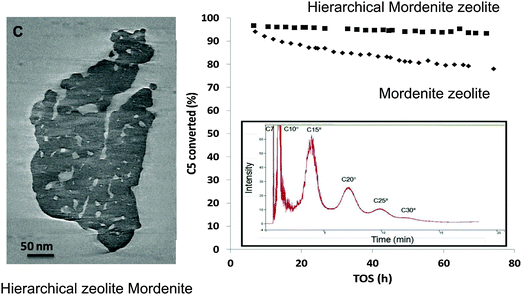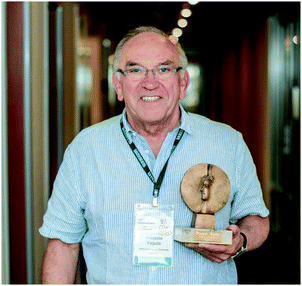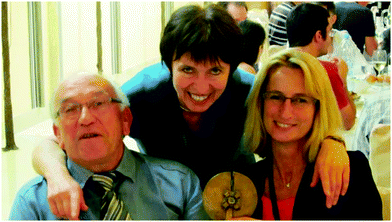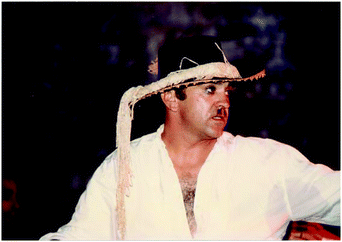Introduction to the themed issue in honor of Dr François Fajula: “An exciting journey in the creative world of ordered porous materials and their applications”
Anne
Galarneau
*a and
Irina I.
Ivanova
*bc
aInstitut Charles Gerhardt Montpellier, UMR 5253 CNRS-Université de Montpellier-ENSCM, ENSCM, 8 rue de l'Ecole Normale, 34296 Montpellier Cedex 05, France. E-mail: anne.galarneau@enscm.fr
bDepartment of Chemistry, M.V. Lomonosov Moscow State University, Lenin Hills 1/3, 119991 Moscow, Russia. E-mail: iiivanova@phys.chem.msu.ru
cA.V. Topchiev Institute of Petrochemical Synthesis, Russian Academy of Science, Leninskiy prospect 29, 119991 Moscow, Russia
• novel zeolite structures;
• zeotypes with extraordinary Lewis acidity and/or redox properties;
• hierarchically ordered porous solids which include zeolites;
• meso-/macroporous silicas or zeolite materials obtained by techniques such as surfactant templating, spinodal decomposition, ice templating and inverse opal formation;
• porous hybrid solids such as metal organic frameworks (MOFs).
Furthermore, existing materials have been improved significantly thanks to the creation of well-controlled secondary meso- and/or macroporosity, and better regulation of both particle size and nanoparticle morphology in order to improve mass transport and diffusion of molecules and ions. The discovery of new materials stimulated the development of tools for their characterization and modeling, which is a top priority for better understanding and further development of these materials. All these achievements resulted in significant breakthroughs in the application of ordered porous solids in both traditional and emerging areas, such as oil refining and petrochemistry, synthesis of chemicals and fine chemicals, environmental issues, adsorption and separation, as well as health protection, design of electronics, sensors, etc.
The work of François Fajula is a perfect example of this evolution (see selected ref. 1–18), and the present themed issue is dedicated to François in recognition of his exceptional contributions to the field of ordered porous solids and on the occasion of his retirement. This editorial is entitled “An exciting journey in the creative world of ordered porous materials and their applications”. This was the title given by François to one of the most remarkable lectures he presented as Ambassador (2013–2016) of the International Zeolite Association (IZA).
Dr François Fajula is well-known to the scientific community as an outstanding researcher in the fields of heterogeneous catalysis and materials science. His strong leadership in the areas of zeolites,3–10,14 ordered mesoporous oxides,11,12,15,16,18 other ordered porous materials and their applications in catalysis and adsorption is recognized all over the world by both academia and industry. His main achievements are twofold:
• first, the unraveling of the molecular mechanisms of hydrocarbon conversion over acidic and metal-containing catalysts,14,15,18 which contributed significantly to a better understanding of refinery processes, including cracking, hydrocracking14,15,18 and hydroisomerization;
• second, the development of broad know-how for the hydrothermal synthesis and post-synthesis modification of zeolites14,17,18 and ordered porous solids,15,18 which led to the design of highly efficient and stable solid catalysts.
His two latest achievements are connected with the development of highly efficient catalysts for increasing middle distillate production:15,18
• oligomerization catalysts based on hierarchical mordenite obtained by controlled dealumination and desilication, which demonstrate highly stable and selective performance in the production of C15–C30 oligomers (Fig. 1);17
 | ||
| Fig. 1 Left: 3D electronic tomography image of hierarchical mordenite zeolite. Right: stable oligomerization of pentene over the hierarchical mordenite zeolite (squares) in comparison to the deactivation of the mordenite zeolite (diamonds). Inset: typical chromatogram showing the oligomer distribution obtained with the hierarchical zeolite. Adapted from ref. 17 with permission from Elsevier (copyright 2016). | ||
• hydrocracking catalysts based on mesoporous zeolites and ordered mesoporous aluminosilicate active components with unique textural characteristics.15,18
François Fajula majored in physical chemistry and obtained his PhD and Doctorate ès Sciences in Catalysis in 1978 from the University of Strasbourg (France). After a post-doc at Texas A&M (College Station, TX, USA), he settled in Montpellier (at the Ecole Nationale Supérieure de Chimie de Montpellier, France) as a CNRS researcher in 1981, where he established a group working in the fields of zeolite synthesis and catalysis, in close cooperation with major refining and chemical companies (ELF-Total SA from 1981 to 2015). From 2007 to 2014, he was the director of the Institute Charles Gerhardt Montpellier (ICGM)—Institute for Molecular and Materials Chemistry in Montpellier, a CNRS-associated laboratory with 220 permanent staff covering a broad range of expertise, including catalysis, quantum chemistry, biochemistry, organic and inorganic synthesis, polymer and materials sciences, spectroscopy and life sciences.
His list of publications is truly impressive, as it comprises over 270 scientific papers published in high-quality journals and books, which have been cited more than 5500 times (his h index is 46). François holds 35 original patents, some of which were implemented at the industrial level. Furthermore, he finds particular pleasure in transmitting his passion for science, and chemistry in particular, to the next generation of young researchers.
Besides his significant contributions to science, François has invested a great deal of his time in serving the research community at the national and international levels. He acted as the chairman of the 13th International Zeolite Conference in 2001 and was the elected President of the International Zeolite Association from 2004 to 2010. He has served as an Editorial Board member of numerous journals, including NJC (from 2002 to 2012).
François Fajula has received a remarkable number of scientific awards and honors for his outstanding achievements in zeolite materials science and heterogeneous catalysis. His work was recognized with the CNRS bronze medal in 1986 and with the P. Süe award from the French Chemical Society in 2005. The CNRS promoted him to the highest researcher grade in France (DRCE2) in 2013. That same year, in recognition of his outstanding achievements in the synthesis and modification of zeolites and porous materials and their application as catalysts in refining and petrochemistry, he received the IZA award (Fig. 2), the most prestigious award of the International Zeolite Association. The recipient of this award serves as IZA Ambassador to the world zeolite community for 3 years, giving lectures all over the world. During the last three years, François has shared his enormous knowledge and invaluable expertise with scientists from Europe, Indonesia, Russia, China, Japan, North America and South America.
 | ||
| Fig. 2 François Fajula with his IZA award received in July 2013 in Moscow, Russia, during the 17th IZC conference. | ||
Those who are lucky enough to have a closer relationship with François Fajula know that he has a great personality and is a wonderful friend. Much can be said about his broad personal interests beyond science. His main hobby is theater (Fig. 3), where he excels as a brilliant actor and stage manager; he enjoys music, literature and the arts, and also likes mountain skiing. François is always optimistic, joyful and friendly.
This themed issue is a way to express our deep appreciation and convey our thanks to François Fajula for his outstanding contributions to the fields of zeolites and ordered porous materials, and for his dedication to our community.
We would like to acknowledge all the authors who have participated in this issue, the editorial team of NJC, and specifically Dr Denise Parent for her great efforts and help in the realization of this initiative. We are absolutely sure that François will be very pleased and honored with this gift from his numerous friends and colleagues (Fig. 4) in recognition of his exceptional contributions to chemistry.
 | ||
| Fig. 4 Guest editors Irina Ivanova (middle) and Anne Galarneau (right) with François Fajula (left) at the 17th IZC conference in 2013 in Moscow, Russia. | ||
Acknowledgements
III would like to thank St-Nikon Foundation for continuous support.References
- F. Fajula and F. G. Gault, Skeletal rearrangements of 13C labeled methylpentenes and methylhexenes on supported p-toluene sulfonic acid, J. Am. Chem. Soc., 1976, 98, 7690–7698 CrossRef CAS.
- F. Fajula, R. G. Anthony and J. H. Lunsford, Methane and methanol synthesis over supported palladium catalysts, J. Catal., 1982, 73, 237–256 CrossRef CAS.
- M. Daage and F. Fajula, Isomerization and cracking of 13C labeled hexanes over H-mordenite. 1. Labeling of the products and general reaction scheme, J. Catal., 1983, 81, 394–404 CrossRef CAS.
- F. Fajula, R. Ibarra, F. Figueras and C. Gueguen, Hydration of normal-butenes using zeolite catalysts—Influence of the aluminum content on activity, J. Catal., 1984, 89, 60–68 CrossRef CAS.
- E. Bourgeat Lami, P. Massiani, F. Di Renzo, P. Espiau, F. Fajula and T. Des Courieres, Study of the state of aluminum in zeolite-beta, Appl. Catal., 1991, 72, 139–152 CrossRef CAS.
- F. Di Renzo, F. Fajula, F. Figueras and T. Des Courieres, Zeolite from the class of mazzite, process for its synthesis, and its use as a catalyst, US Pat., 5165906, 1992 Search PubMed.
- F. Fajula, F. Figueras, C. Guegen and R. Dutarte, Binary zeolitic systems, their synthesis and their utilization, US Pat., 4946580, 1990 Search PubMed.
- F. Di Renzo, R. Dutartre, P. Espiau, F. Fajula and M. A. Nicolle, The influence of microgravity on zeolite crystallization, Zeolites, 1994, 14, 256–261 CrossRef CAS.
- F. Fajula, J. Patarin, T. Descourieres and F. Fitoussi, Process for the synthesis of a silica enriched crystalline aluminosilicate having the offretite structure, the aluminosilicate obtained and its use as a catalyst for the conversion of hydrocarbons, US Pat., 5534239, 1996 Search PubMed.
- N. Kubicek, F. Vaudry, B. H. Chiche, P. Hudec, F. Di Renzo, P. Schultz and F. Fajula, Stabilization of zeolite beta for fcc application by embedding in amorphous matrix, Appl. Catal., A, 1998, 175, 159–171 CrossRef CAS.
- B. Chiche, E. Sauvage, F. Di Renzo, I. I. Ivanova and F. Fajula, Butene oligomerization over mesoporous MTS-type aluminosilicates, J. Mol. Catal., 1998, 134, 145–157 CrossRef CAS.
- F. Fajula and D. Brunel, Unique surface and catalytic properties of mesoporous aluminosilicates, Microporous Mesoporous Mater., 2001, 48, 119–125 CrossRef CAS.
- A. Rabion, F. Fajula, J. R. Bernard and V. Hulea, Method for desulfurizing thiophene derivatives contained in fuels, US Pat., 7179368, 2007 Search PubMed.
- K. P. De Jong, J. Zecevic, H. Friedrich, P. E. De Jongh, M. Bulut, S. Van Donk, R. Kenmogne, A. Finiels, V. Hulea and F. Fajula, Zeolite Y Crystals with Trimodal Porosity as Ideal Hydrocracking Catalysts, Angew. Chem., Int. Ed., 2010, 49, 10074–10078 CrossRef CAS PubMed.
- R. Kenmogne, S. Van Donk, J. P. Dath, M. Bulut, A. Finiel, V. Hulea and F. Fajula, Method of preparing a hydroprocessing catalyst based on silica or silica-alumina having an interconnected mesoporous texture, US Pat., 20130299388 A1, 2013 Search PubMed.
- A. Finiels, F. Fajula and V. Hulea, Nickel-based solid catalyst for ethylene oligomerization–a review, Catal. Sci. Technol., 2014, 4, 2412–2426 CAS.
- C. Bertrand-Drira, X. W. Cheng, T. Cacciaguerra, P. Trens, G. Melinte, O. Ersen, D. Minoux, A. Finiels, F. Fajula and C. Gerardin, Mesoporous mordenites obtained by desilication: Mechanistic considerations and evaluation in catalytic oligomerization of pentene, Microporous Mesoporous Mater., 2015, 213, 142–149 CrossRef CAS.
- R. Kenmogne, A. Finiels, V. Hulea, C. Cammarano and F. Fajula, Hydroconversion of n-hexadecane over bifunctional microporous and mesoporous model catalysts. Influence of pore architecture on selectivity, J. Catal., 2015, 329, 348–354 CrossRef CAS.
| This journal is © The Royal Society of Chemistry and the Centre National de la Recherche Scientifique 2016 |

